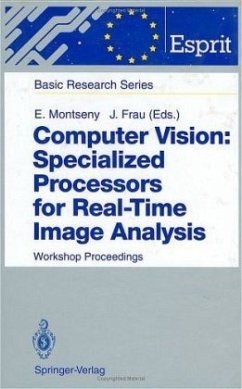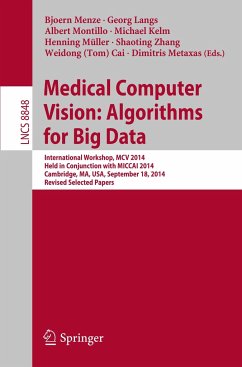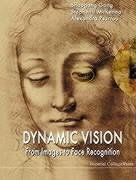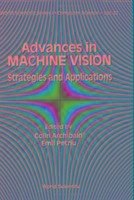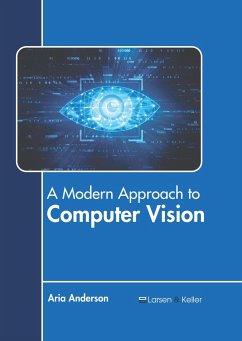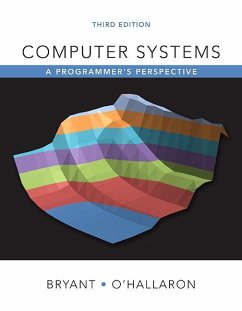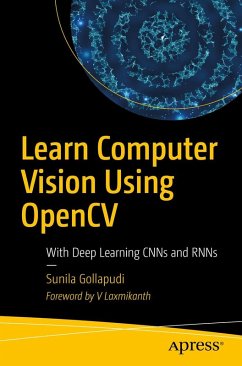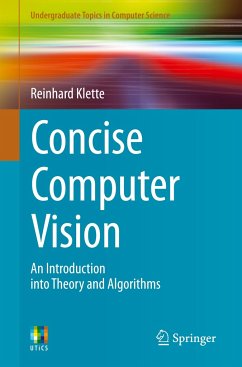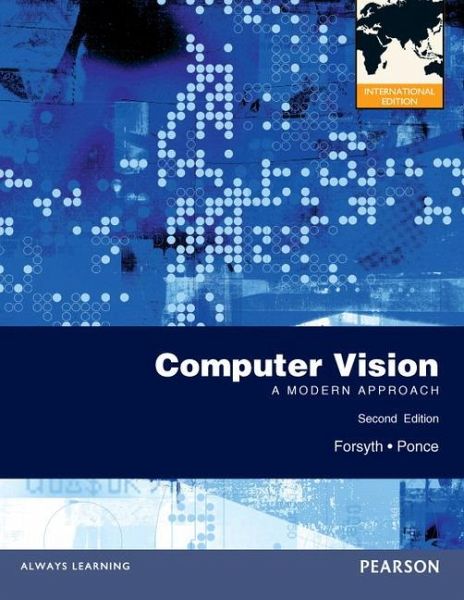
Computer Vision: A Modern Approach
International Edition

PAYBACK Punkte
58 °P sammeln!
Appropriate for upper-division undergraduate- and graduate-level courses in computer vision found in departments of Computer Science, Computer Engineering and Electrical Engineering.
This textbook provides the most complete treatment of modern computer vision methods by two of the leading authorities in the field. This accessible presentation gives both a general view of the entire computer vision enterprise and also offers sufficient detail for students to be able to build useful applications. Students will learn techniques that have proven to be useful by first-hand experience and a wide range of mathematical methods.
Features + Benefits
Broad coverageCoverage of a wide range of topics allows customization to fit instructor, student, and course needs.
Allows instructors to select the most relevant topics for their students and encourages students to enrich their coursework by reading information on other computer vision topics.
Most comprehensive and up-to-date text on computer visionIncludes essential topics that either reflect practical significance or are of theoretical importance.
Provides students with the most coherent synthesis of current views and teaches them successful techniques for building applications.
Depth of the material accessible to various levels of studentsTopics are discussed in substantial and increasing depth.
While the first half of each chapter is accessible to undergraduates, a good grasp of each chapter provides students with a professional level of skill and knowledge.
Application surveysDescribe numerous important application areas such as image based rendering and digital libraries.
Teaches students about practical use of techniques and helps them gain insight into the demands of applications.
Many important algorithms broken down and illustrated in pseudo code.
Enables students to build working systems easily as they can understand the construction of the final application.
Excellent pedagogy throughout the textIncludes numerous worked examples, exercises, programming assignments, and extensive illustrations.
Provides students with ample opportunity to apply the concepts in the text.
I IMAGE FORMATION 1
1 Geometric Camera Models 3
1.1 Image Formation . . . . . . . . . . . . . . . . . . . . . . . . . . . . . 4
1.1.1 Pinhole Perspective . . . . . . . . . . . . . . . . . . . . . . . 4
1.1.2 Weak Perspective . . . . . . . . . . . . . . . . . . . . . . . . . 6
1.1.3 Cameras with Lenses . . . . . . . . . . . . . . . . . . . . . . . 8
1.1.4 The Human Eye . . . . . . . . . . . . . . . . . . . . . . . . . 12
1.2 Intrinsic and Extrinsic Parameters . . . . . . . . . . . . . . . . . . . 14
1.2.1 Rigid Transformations and Homogeneous Coordinates . . . . 14
1.2.2 Intrinsic Parameters . . . . . . . . . . . . . . . . . . . . . . . 16
1.2.3 Extrinsic Parameters . . . . . . . . . . . . . . . . . . . . . . . 18
1.2.4 Perspective Projection Matrices . . . . . . . . . . . . . . . . . 19
1.2.5 Weak-Perspective Projection Matrices . . . . . . . . . . . . . 20
1.3 Geometric Camera Calibration . . . . . . . . . . . . . . . . . . . . . 22
1.3.1 ALinear Approach to Camera Calibration . . . . . . . . . . . 23
1.3.2 ANonlinear Approach to Camera Calibration . . . . . . . . . 27
1.4 Notes . . . . . . . . . . . . . . . . . . . . . . . . . . . . . . . . . . . 29
2 Light and Shading 32
2.1 Modelling Pixel Brightness . . . . . . . . . . . . . . . . . . . . . . . 32
2.1.1 Reflection at Surfaces . . . . . . . . . . . . . . . . . . . . . . 33
2.1.2 Sources and Their Effects . . . . . . . . . . . . . . . . . . . . 34
2.1.3 The Lambertian+Specular Model . . . . . . . . . . . . . . . . 36
2.1.4 Area Sources . . . . . . . . . . . . . . . . . . . . . . . . . . . 36
2.2 Inference from Shading . . . . . . . . . . . . . . . . . . . . . . . . . . 37
2.2.1 Radiometric Calibration and High Dynamic Range Images . . 38
2.2.2 The Shape of Specularities . . . . . . . . . . . . . . . . . . . 40
2.2.3 Inferring Lightness and Illumination . . . . . . . . . . . . . . 43
2.2.4 Photometric Stereo: Shape from Multiple Shaded Images . . 46
2.3 Modelling Interreflection . . . . . . . . . . . . . . . . . . . . . . . . . 52
2.3.1 The Illumination at a Patch Due to an Area Source . . . . . 52
2.3.2 Radiosity and Exitance . . . . . . . . . . . . . . . . . . . . . 54
2.3.3 An Interreflection Model . . . . . . . . . . . . . . . . . . . . . 55
2.3.4 Qualitative Properties of Interreflections . . . . . . . . . . . . 56
2.4 Shape from One Shaded Image . . . . . . . . . . . . . . . . . . . . . 59
2.5 Notes . . . . . . . . . . . . . . . . . . . . . . . . . . . . . . . . . . . 61
3 Color 68
3.1 Human Color Perception . . . . . . . . . . . . . . . . . . . . . . . . . 68
3.1.1 Color Matching . . . . . . . . . . . . . . . . . . . . . . . . . . 68
3.1.2 Color Receptors . . . . . . . . . . . . . . . . . . . . . . . . . 71
3.2 The Physics of Color . . . . . . . . . . . . . . . . . . . . . . . . . . . 73
3.2.1 The Color of Light Sources . . . . . . . . . . . . . . . . . . . 73
3.2.2 The Color of Surfaces . . . . . . . . . . . . . . . . . . . . . . 76
3.3 Representing Color . . . . . . . . . . . . . . . . . . . . . . . . . . . . 77
3.3.1 Linear Color Spaces . . . . . . . . . . . . . . . . . . . . . . . 77
3.3.2 Non-linear Color Spaces . . . . . . . . . . . . . . . . . . . . . 83
3.4 AModel of Image Color . . . . . . . . . . . . . . . . . . . . . . . . . 86
3.4.1 The Diffuse Term . . . . . . . . . . . . . . . . . . . . . . . . . 88
3.4.2 The Specular Term . . . . . . . . . . . . . . . . . . . . . . . . 90
3.5 Inference from Color . . . . . . . . . . . . . . . . . . . . . . . . . . . 90
3.5.1 Finding Specularities Using Color . . . . . . . . . . . . . . . 90
3.5.2 Shadow Removal Using Color . . . . . . . . . . . . . . . . . . 92
3.5.3 Color Constancy: Surface Color from Image Color . . . . . . 95
3.6 Notes . . . . . . . . . . . . . . . . . . . . . . . . . . . . . . . . . . . 99
II EARLY VISION: JUST ONE IMAGE 105
4 Linear Filters 107
4.1 Linear Filters and Convolution . . . . . . . . . . . . . . . . . . . . . 107
4.1.1 Convolution . . . . . . . . . . . . . . . . . . . . . . . . . . . . 107
4.2 Shift Invariant Linear Systems . . . . . . . . . . . . . . . . . . . . . 112
4.2.1 Discrete Convolution . . . . . . . . . . . . . . . . . . . . . . . 113
4.2.2 Continuous Convolution . . . . . . . . . . . . . . . . . . . . . 115
4.2.3 Edge Effects in Discrete Convolutions . . . . . . . . . . . . . 118
4.3 Spatial Frequency and Fourier Transforms . . . . . . . . . . . . . . . 118
4.3.1 Fourier Transforms . . . . . . . . . . . . . . . . . . . . . . . . 119
4.4 Sampling and Aliasing . . . . . . . . . . . . . . . . . . . . . . . . . . 121
4.4.1 Sampling . . . . . . . . . . . . . . . . . . . . . . . . . . . . . 122
4.4.2 Aliasing . . . . . . . . . . . . . . . . . . . . . . . . . . . . . . 125
4.4.3 Smoothing and Resampling . . . . . . . . . . . . . . . . . . . 126
4.5 Filters as Templates . . . . . . . . . . . . . . . . . . . . . . . . . . . 131
4.5.1 Convolution as a Dot Product . . . . . . . . . . . . . . . . . 131
4.5.2 Changing Basis . . . . . . . . . . . . . . . . . . . . . . . . . . 132
4.6 Technique: Normalized Correlation and Finding Patterns . . . . . . 132
4.6.1 Controlling the Television by Finding Hands by Normalized
Correlation . . . . . . . . . . . . . . . . . . . . . . . . . . . . 133
4.7 Technique: Scale and Image Pyramids . . . . . . . . . . . . . . . . . 134
4.7.1 The Gaussian Pyramid . . . . . . . . . . . . . . . . . . . . . 135
4.7.2 Applications of Scaled Representations . . . . . . . . . . . . . 136
4.8 Notes . . . . . . . . . . . . . . . . . . . . . . . . . . . . . . . . . . . 137
5 Local Image Features 141
5.1 Computing the Image Gradient . . . . . . . . . . . . . . . . . . . . . 141
5.1.1 Derivative of Gaussian Filters . . . . . . . . . . . . . . . . . . 142
5.2 Representing the Image Gradient . . . . . . . . . . . . . . . . . . . . 144
5.2.1 Gradient-Based Edge Detectors . . . . . . . . . . . . . . . . . 145
5.2.2 Orientations . . . . . . . . . . . . . . . . . . . . . . . . . . . . 147
5.3 Finding Corners and Building Neighborhoods . . . . . . . . . . . . . 148
5.3.1 Finding Corners . . . . . . . . . . . . . . . . . . . . . . . . . 149
5.3.2 Using Scale and Orientation to Build a Neighborhood . . . . 151
5.4 Describing Neighborhoods with SIFT and HOG Features . . . . . . 155
5.4.1 SIFT Features . . . . . . . . . . . . . . . . . . . . . . . . . . 157
5.4.2 HOG Features . . . . . . . . . . . . . . . . . . . . . . . . . . 159
5.5 Computing Local Features in Practice . . . . . . . . . . . . . . . . . 160
5.6 Notes . . . . . . . . . . . . . . . . . . . . . . . . . . . . . . . . . . . 160
6 Texture 164
6.1 Local Texture Representations Using Filters . . . . . . . . . . . . . . 166
6.1.1 Spots and Bars . . . . . . . . . . . . . . . . . . . . . . . . . . 167
6.1.2 From Filter Outputs to Texture Representation . . . . . . . . 168
6.1.3 Local Texture Representations in Practice . . . . . . . . . . . 170
6.2 Pooled Texture Representations by Discovering Textons . . . . . . . 171
6.2.1 Vector Quantization and Textons . . . . . . . . . . . . . . . . 172
6.2.2 K-means Clustering for Vector Quantization . . . . . . . . . . 172
6.3 Synthesizing Textures and Filling Holes in Images . . . . . . . . . . 176
6.3.1 Synthesis by Sampling Local Models . . . . . . . . . . . . . . 176
6.3.2 Filling in Holes in Images . . . . . . . . . . . . . . . . . . . . 179
6.4 Image Denoising . . . . . . . . . . . . . . . . . . . . . . . . . . . . . 182
6.4.1 Non-local Means . . . . . . . . . . . . . . . . . . . . . . . . . 183
6.4.2 Block Matching 3D (BM3D) . . . . . . . . . . . . . . . . . . 183
6.4.3 Learned Sparse Coding . . . . . . . . . . . . . . . . . . . . . 184
6.4.4 Results . . . . . . . . . . . . . . . . . . . . .
This textbook provides the most complete treatment of modern computer vision methods by two of the leading authorities in the field. This accessible presentation gives both a general view of the entire computer vision enterprise and also offers sufficient detail for students to be able to build useful applications. Students will learn techniques that have proven to be useful by first-hand experience and a wide range of mathematical methods.
Features + Benefits
Broad coverageCoverage of a wide range of topics allows customization to fit instructor, student, and course needs.
Allows instructors to select the most relevant topics for their students and encourages students to enrich their coursework by reading information on other computer vision topics.
Most comprehensive and up-to-date text on computer visionIncludes essential topics that either reflect practical significance or are of theoretical importance.
Provides students with the most coherent synthesis of current views and teaches them successful techniques for building applications.
Depth of the material accessible to various levels of studentsTopics are discussed in substantial and increasing depth.
While the first half of each chapter is accessible to undergraduates, a good grasp of each chapter provides students with a professional level of skill and knowledge.
Application surveysDescribe numerous important application areas such as image based rendering and digital libraries.
Teaches students about practical use of techniques and helps them gain insight into the demands of applications.
Many important algorithms broken down and illustrated in pseudo code.
Enables students to build working systems easily as they can understand the construction of the final application.
Excellent pedagogy throughout the textIncludes numerous worked examples, exercises, programming assignments, and extensive illustrations.
Provides students with ample opportunity to apply the concepts in the text.
I IMAGE FORMATION 1
1 Geometric Camera Models 3
1.1 Image Formation . . . . . . . . . . . . . . . . . . . . . . . . . . . . . 4
1.1.1 Pinhole Perspective . . . . . . . . . . . . . . . . . . . . . . . 4
1.1.2 Weak Perspective . . . . . . . . . . . . . . . . . . . . . . . . . 6
1.1.3 Cameras with Lenses . . . . . . . . . . . . . . . . . . . . . . . 8
1.1.4 The Human Eye . . . . . . . . . . . . . . . . . . . . . . . . . 12
1.2 Intrinsic and Extrinsic Parameters . . . . . . . . . . . . . . . . . . . 14
1.2.1 Rigid Transformations and Homogeneous Coordinates . . . . 14
1.2.2 Intrinsic Parameters . . . . . . . . . . . . . . . . . . . . . . . 16
1.2.3 Extrinsic Parameters . . . . . . . . . . . . . . . . . . . . . . . 18
1.2.4 Perspective Projection Matrices . . . . . . . . . . . . . . . . . 19
1.2.5 Weak-Perspective Projection Matrices . . . . . . . . . . . . . 20
1.3 Geometric Camera Calibration . . . . . . . . . . . . . . . . . . . . . 22
1.3.1 ALinear Approach to Camera Calibration . . . . . . . . . . . 23
1.3.2 ANonlinear Approach to Camera Calibration . . . . . . . . . 27
1.4 Notes . . . . . . . . . . . . . . . . . . . . . . . . . . . . . . . . . . . 29
2 Light and Shading 32
2.1 Modelling Pixel Brightness . . . . . . . . . . . . . . . . . . . . . . . 32
2.1.1 Reflection at Surfaces . . . . . . . . . . . . . . . . . . . . . . 33
2.1.2 Sources and Their Effects . . . . . . . . . . . . . . . . . . . . 34
2.1.3 The Lambertian+Specular Model . . . . . . . . . . . . . . . . 36
2.1.4 Area Sources . . . . . . . . . . . . . . . . . . . . . . . . . . . 36
2.2 Inference from Shading . . . . . . . . . . . . . . . . . . . . . . . . . . 37
2.2.1 Radiometric Calibration and High Dynamic Range Images . . 38
2.2.2 The Shape of Specularities . . . . . . . . . . . . . . . . . . . 40
2.2.3 Inferring Lightness and Illumination . . . . . . . . . . . . . . 43
2.2.4 Photometric Stereo: Shape from Multiple Shaded Images . . 46
2.3 Modelling Interreflection . . . . . . . . . . . . . . . . . . . . . . . . . 52
2.3.1 The Illumination at a Patch Due to an Area Source . . . . . 52
2.3.2 Radiosity and Exitance . . . . . . . . . . . . . . . . . . . . . 54
2.3.3 An Interreflection Model . . . . . . . . . . . . . . . . . . . . . 55
2.3.4 Qualitative Properties of Interreflections . . . . . . . . . . . . 56
2.4 Shape from One Shaded Image . . . . . . . . . . . . . . . . . . . . . 59
2.5 Notes . . . . . . . . . . . . . . . . . . . . . . . . . . . . . . . . . . . 61
3 Color 68
3.1 Human Color Perception . . . . . . . . . . . . . . . . . . . . . . . . . 68
3.1.1 Color Matching . . . . . . . . . . . . . . . . . . . . . . . . . . 68
3.1.2 Color Receptors . . . . . . . . . . . . . . . . . . . . . . . . . 71
3.2 The Physics of Color . . . . . . . . . . . . . . . . . . . . . . . . . . . 73
3.2.1 The Color of Light Sources . . . . . . . . . . . . . . . . . . . 73
3.2.2 The Color of Surfaces . . . . . . . . . . . . . . . . . . . . . . 76
3.3 Representing Color . . . . . . . . . . . . . . . . . . . . . . . . . . . . 77
3.3.1 Linear Color Spaces . . . . . . . . . . . . . . . . . . . . . . . 77
3.3.2 Non-linear Color Spaces . . . . . . . . . . . . . . . . . . . . . 83
3.4 AModel of Image Color . . . . . . . . . . . . . . . . . . . . . . . . . 86
3.4.1 The Diffuse Term . . . . . . . . . . . . . . . . . . . . . . . . . 88
3.4.2 The Specular Term . . . . . . . . . . . . . . . . . . . . . . . . 90
3.5 Inference from Color . . . . . . . . . . . . . . . . . . . . . . . . . . . 90
3.5.1 Finding Specularities Using Color . . . . . . . . . . . . . . . 90
3.5.2 Shadow Removal Using Color . . . . . . . . . . . . . . . . . . 92
3.5.3 Color Constancy: Surface Color from Image Color . . . . . . 95
3.6 Notes . . . . . . . . . . . . . . . . . . . . . . . . . . . . . . . . . . . 99
II EARLY VISION: JUST ONE IMAGE 105
4 Linear Filters 107
4.1 Linear Filters and Convolution . . . . . . . . . . . . . . . . . . . . . 107
4.1.1 Convolution . . . . . . . . . . . . . . . . . . . . . . . . . . . . 107
4.2 Shift Invariant Linear Systems . . . . . . . . . . . . . . . . . . . . . 112
4.2.1 Discrete Convolution . . . . . . . . . . . . . . . . . . . . . . . 113
4.2.2 Continuous Convolution . . . . . . . . . . . . . . . . . . . . . 115
4.2.3 Edge Effects in Discrete Convolutions . . . . . . . . . . . . . 118
4.3 Spatial Frequency and Fourier Transforms . . . . . . . . . . . . . . . 118
4.3.1 Fourier Transforms . . . . . . . . . . . . . . . . . . . . . . . . 119
4.4 Sampling and Aliasing . . . . . . . . . . . . . . . . . . . . . . . . . . 121
4.4.1 Sampling . . . . . . . . . . . . . . . . . . . . . . . . . . . . . 122
4.4.2 Aliasing . . . . . . . . . . . . . . . . . . . . . . . . . . . . . . 125
4.4.3 Smoothing and Resampling . . . . . . . . . . . . . . . . . . . 126
4.5 Filters as Templates . . . . . . . . . . . . . . . . . . . . . . . . . . . 131
4.5.1 Convolution as a Dot Product . . . . . . . . . . . . . . . . . 131
4.5.2 Changing Basis . . . . . . . . . . . . . . . . . . . . . . . . . . 132
4.6 Technique: Normalized Correlation and Finding Patterns . . . . . . 132
4.6.1 Controlling the Television by Finding Hands by Normalized
Correlation . . . . . . . . . . . . . . . . . . . . . . . . . . . . 133
4.7 Technique: Scale and Image Pyramids . . . . . . . . . . . . . . . . . 134
4.7.1 The Gaussian Pyramid . . . . . . . . . . . . . . . . . . . . . 135
4.7.2 Applications of Scaled Representations . . . . . . . . . . . . . 136
4.8 Notes . . . . . . . . . . . . . . . . . . . . . . . . . . . . . . . . . . . 137
5 Local Image Features 141
5.1 Computing the Image Gradient . . . . . . . . . . . . . . . . . . . . . 141
5.1.1 Derivative of Gaussian Filters . . . . . . . . . . . . . . . . . . 142
5.2 Representing the Image Gradient . . . . . . . . . . . . . . . . . . . . 144
5.2.1 Gradient-Based Edge Detectors . . . . . . . . . . . . . . . . . 145
5.2.2 Orientations . . . . . . . . . . . . . . . . . . . . . . . . . . . . 147
5.3 Finding Corners and Building Neighborhoods . . . . . . . . . . . . . 148
5.3.1 Finding Corners . . . . . . . . . . . . . . . . . . . . . . . . . 149
5.3.2 Using Scale and Orientation to Build a Neighborhood . . . . 151
5.4 Describing Neighborhoods with SIFT and HOG Features . . . . . . 155
5.4.1 SIFT Features . . . . . . . . . . . . . . . . . . . . . . . . . . 157
5.4.2 HOG Features . . . . . . . . . . . . . . . . . . . . . . . . . . 159
5.5 Computing Local Features in Practice . . . . . . . . . . . . . . . . . 160
5.6 Notes . . . . . . . . . . . . . . . . . . . . . . . . . . . . . . . . . . . 160
6 Texture 164
6.1 Local Texture Representations Using Filters . . . . . . . . . . . . . . 166
6.1.1 Spots and Bars . . . . . . . . . . . . . . . . . . . . . . . . . . 167
6.1.2 From Filter Outputs to Texture Representation . . . . . . . . 168
6.1.3 Local Texture Representations in Practice . . . . . . . . . . . 170
6.2 Pooled Texture Representations by Discovering Textons . . . . . . . 171
6.2.1 Vector Quantization and Textons . . . . . . . . . . . . . . . . 172
6.2.2 K-means Clustering for Vector Quantization . . . . . . . . . . 172
6.3 Synthesizing Textures and Filling Holes in Images . . . . . . . . . . 176
6.3.1 Synthesis by Sampling Local Models . . . . . . . . . . . . . . 176
6.3.2 Filling in Holes in Images . . . . . . . . . . . . . . . . . . . . 179
6.4 Image Denoising . . . . . . . . . . . . . . . . . . . . . . . . . . . . . 182
6.4.1 Non-local Means . . . . . . . . . . . . . . . . . . . . . . . . . 183
6.4.2 Block Matching 3D (BM3D) . . . . . . . . . . . . . . . . . . 183
6.4.3 Learned Sparse Coding . . . . . . . . . . . . . . . . . . . . . 184
6.4.4 Results . . . . . . . . . . . . . . . . . . . . .
Appropriate for upper-division undergraduate- and graduate-level courses in computer vision found in departments of Computer Science, Computer Engineering and Electrical Engineering.
This textbook provides the most complete treatment of modern computer vision methods by two of the leading authorities in the field. This accessible presentation gives both a general view of the entire computer vision enterprise and also offers sufficient detail for students to be able to build useful applications. Students will learn techniques that have proven to be useful by first-hand experience and a wide range of mathematical methods.
This textbook provides the most complete treatment of modern computer vision methods by two of the leading authorities in the field. This accessible presentation gives both a general view of the entire computer vision enterprise and also offers sufficient detail for students to be able to build useful applications. Students will learn techniques that have proven to be useful by first-hand experience and a wide range of mathematical methods.
Dieser Artikel kann nur an eine deutsche Lieferadresse ausgeliefert werden.




